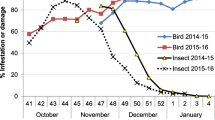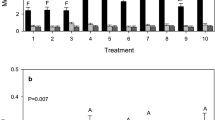Abstract
Many mites of the family Eriophyidae are important pests worldwide. In citrus crops, the eriophyid Phyllocoptruta oleivora stands out for the economic losses caused. The pest’s injuries cause the darkening of leaves, twigs, and fruits, making them unfit for the fresh fruit market and affecting plant productivity. Another species that causes similar symptoms was described in Brazil recently, the brown citrus rust mite, Tegolophus brunneus. Although studies have not been performed with this species, growers and technicians have attributed the rise in rust damages in Brazil to T. brunneus, affirming that this mite is more aggressive and resistant to acaricides than P. oleivora. In this study, the distribution of T. brunneus in the main Brazilian citrus belt and the differential toxicity of the acaricides sulfur and abamectin were evaluated for both species. Infested fruits were collected from different orchards in many municipalities, covering the main citrus species and cultivars grown, aiming to show the main T. brunneus hosts. It was observed that only plants of Tahiti acid lime (Citrus latifolia) were infested by T. brunneus, whereas P. oleivora infested all citrus cultivars and species evaluated (Citrus spp.). In our study, T. brunneus and P. oleivora were never observed coinfesting the same fruit/leaf or plant. The acute toxicity test of sulfur and abamectin as acaricides showed that T. brunneus has greater tolerance to abamectin than P. oleivora. However, the acute toxicity of sulfur was similar for both species. These results showed T. brunneus specificity to infest Tahiti acid lime, causing important damage to this crop, and suggest that attention should be paid to managing this mite using abamectin.



Similar content being viewed by others
References
Albuquerque FA (2006) Diversidade de ácaros em cultivo orgânico de citros e na vegetação natural circundante, e perspectivas para a criação massal de Iphiseiodes zuluagai (Acari: Phytoseiidae). Dissertation, São Paulo State University (Unesp-FCAV). Available: https://repositorio.unesp.br/handle/11449/102299
Bobot TDE, Franklin E, Navia D, Gasnier TRJ, Lofego AC, Oliveira BM (2011) Mites (Arachnida, Acari) on Citrus sinensis L. Osbeck orange trees in the state of Amazonas, Northern Brazil. Acta Amazon 41:557–566. https://doi.org/10.1590/S0044-59672011000400013
Bressan LR, Ott AP (2017) Distribuição intra-planta e flutuação populacional de Tegolophus brunneus (Acari: Eriophyidae: Phyllocoptinae) em tangerineira. Caderno De Pesquisa 29:23–29. https://doi.org/10.17058/cp.v29i3.10419
Cordeiro EMG, Corrêa AS, Guedes RNC (2014) Insecticide-mediated shift in ecological dominance between two competing species of grain beetles. PLoS ONE 9:e100990. https://doi.org/10.1371/journal.pone.0100990
de Lillo E, Pozzebon A, Valenzano D, Duso C (2018) An intimate relationship between eriophyoid mites and their host plants–a review. Front Plant Sci 9:1786. https://doi.org/10.3389/fpls.2018.01786
Dicke M (2000) Chemical ecology of host-plant selection by herbivorous arthropods: a multitrophic perspective. Biochem Syst Ecol 28:601–617. https://doi.org/10.1016/S0305-1978(99)00106-4
Donkersley P, Silva FW, Carvalho CM, Al-Sadi AM, Elliot SL (2018) Biological, environmental and socioeconomic threats to citrus lime production. J Plant Dis Protect 125:339–356. https://doi.org/10.1007/s41348-018-0160-x
Ferreira CT, Krug C, Garcia MVB, Moraes GJ (2018) Leprosis mite and other mite species (Acari) associated to orange groves in Brazilian Central Amazon. Syst Appl Acarol 23:449–462. https://doi.org/10.11158/saa.23.3.4
Flechtmann CH (1999) Tegolophus brunneus n. sp., a new citrus rust mite from Brazil (Acari: Eriophyidae). I J Acarol 25:265–267. https://doi.org/10.1080/01647959908684163
Fundecitrus (2022) Tree inventory of the São Paulo and West-Southwest Minas Gerais citrus belt (2022). Available: https://www.fundecitrus.com.br/pdf/pes_relatorios/2022_07_01_Tree_Inventory_and_Orange_Crop_Forecast_2022-2023.pdf
Gerson U (2003) Acarine pests of citrus: overview and non-chemical control. Syst Appl Acarol 8:3–12. https://doi.org/10.11158/saa.8.1.1
Horn TB, Johann L, Ferla NJ (2011) Ecological interactions between phytophagous and predaceous mites in citrus agroecosystems in Taquari Valley, Rio Grande do sul, Brazil. Syst Appl Acarol 16:133–144. https://doi.org/10.11158/saa.16.2.2
Ibrahim YB, Yee TS (2000) Influence of sublethal exposure to abamectin on the biological performance of Neoseiulus longispinosus (Acari: Phytoseiidae). J Econo Entomol 93:1085–1089. https://doi.org/10.1603/0022-0493-93.4.1085
Kogan M (1998) Integrated pest management: historical perspectives and contemporary developments. Annu Rev Entomol 43:243–270. https://doi.org/10.1146/annurev.ento.43.1.243
Krantz GW, Walter DEA (2009) Collection, rearing and preparation for studying. In: Krantz GW, Walter DEA (eds) A Manual of Acarology. Texas Tech University Press, Lubbock, pp 83–96
Lima DB, Melo JWS, Gondim MGC, Guedes RN, Oliveira JE (2016) Population-level effects of abamectin, azadirachtin and fenpyroximate on the predatory mite Neoseiulus Baraki. Exp Appl Acarol 70:165–177. https://doi.org/10.1007/s10493-016-0074-x
McCoy CW (1996) Pathogens of eriophyoid mites. In: Lindquist EE, Sabelis MW, Bruin J (eds) World Crop pests. Elsevier, Amsterdam, pp 481–490
McCoy CW, Albrigo LG (1975) Feeding injury to the orange caused by the citrus rust mite, Phyllocoptruta oleivora (Prostigmata: Eriophyoidea). Ann Entomol Soc Am 68:289–297. https://doi.org/10.1093/aesa/68.2.289
Messelink GJ, Sabelis MW, Janssen A (2012) Generalist predators, food web complexities and biological pest control in greenhouse crops. In: Soloneski S (ed) Integrated Pest Management and pest control-current and future tactics. InTech, Rijeka, pp 191–214
Morais MR, Zanardi OZ, Andrade DJ (2019) Biological and demographic parameters of Tegolophus brunneus (Acari: Eriophyidae) in citrus. Exp Appl Acarol 79:35–46. https://doi.org/10.1007/s10493-019-00415-y
Oliveira WP (2007) Flutuação e densidade populacional de ácaros (Acari) em três sistemas de produção de citros. 143 f. Dissertation, Universty of São Paulo (CENA- ESALQ/USP). Available: https://doi.org/10.11606/T.91.2007.tde-14052007-145657
Oliveira RC, Neves PMOJ (2004) Compatibility of Beauveria bassiana with acaricides. Neotrop Entomol 33:353–358. https://doi.org/10.1590/S1519-566X2004000300013
Pallini A, Janssen A, Sabelis MW (1997) Odour-mediated responses of phytophagous mites to conspecific and heterospecific competitors. Oecologia 110:179–185. https://doi.org/10.1007/s004420050147
Rincón-Barón EJ, Torres-Rodríguez GA, Guerra-Sierra BE (2022) Histopathological aspects in ripe fruits of Tahiti lime Citrus citrus x latifolia (Rutaceae) affected by phytophagous mites. Persian J Acarol 11:713–729. https://doi.org/10.22073/pja.v11i4.75693
Rodrigues JCV, Oliveira CAL (2005) Ácaros fitófagos dos citros. In: Junior DM, Negri JD, Pio RM, Junior JP (Eds.) Citros. Campinas: Instituto Agronômico, pp 691–727
Sabelis MW, Bruin J (1996) Evolutionary ecology: life history patterns, food plant choice and dispersal. In: Lindquist EE, Bruin J, Sabelis MW (eds) Eriophyoid mites: their Biology, Natural enemies and Control. World Crop pests volume 6. Elsevier, Amsterdam, The Netherlands, pp 329–366
SAS Institute (2011) Statistical analysis system: getting started with the SAS learning. Version 9.2. SAS Institute, Cary
Silva MZ, Sato ME, Oliveira CAL (2012) Diversidade E dinâmica populacional de ácaros em pomar cítrico. Bragantia 71:210–218. https://doi.org/10.1590/S0006-87052012005000013
Smith D, Papacek DF (1991) Studies of the predatory mite Amblyseius victoriensis (Acarina: Phytoseiidae) in citrus orchards in south-east Queensland: control of Tegolophus australis and Phyllocoptruta oleivora (Acarina: Eriophyidae), effect of pesticides, alternative host plants and augmentative release. Exp Appl Acarol 12:195–217. https://doi.org/10.1007/BF01193467
Smith D, Beattie GA, Broadley R (1997) Citrus pests and their natural enemies: integrated pest management in Australia, 272p edn. Dept. of Primary Industries, Queesland
Sun DB, Liu YQ, Qin L, Xu J, Li FF, Liu SS (2013) Competitive displacement between two invasive whiteflies: insecticide application and host plant effects. Bull Entomol Res 103:344–353. https://doi.org/10.1017/S0007485312000788
Vacante V (2010) Citrus mites: identification, bionomy and control. CABI, Walingford, p 371
Van Leeuwen T, Witters J, Nauen R, Duso C, Tirry L (2010) The control of eriophyoid mites: state of the art and future challenges. Exp Appl Acarol 51:205–224. https://doi.org/10.1007/s10493-009-9312-9
Venzon M, Janssen A, Sabelis MW (2001) Prey preference, intraguild predation and population dynamics of an arthropod food web on plants. Exp Appl Acarol 25:785–808. https://doi.org/10.1023/a:1020443401985
Wei J, van Loon JJ, Gols R, Menzel TR, Li, Kang L, Dicke M (2014) Reciprocal crosstalk between jasmonate and salicylate defence-signalling pathways modulates plant volatile emission and herbivore host-selection behavior. J Exp Bot 65:3289–3298. https://doi.org/10.1093/jxb/eru181
Acknowledgments
We thank the São Paulo Research Foundation (FAPESP) for the scholarships to the first and second authors (grant nrs 2016/03992-2 and 2022/04556-2). We thank the National Council for Scientific and Technological Development (CNPq) for granting the research productivity scholarship to DJdeA and the Fund for Citrus Protection (Fundecitrus) for all support. We also thank the citrus-producing companies Cutrale, Fazenda da Toca, Citrosuco, and Simonetti Citrus for allowing collections in their areas. We thank Dr. Carlos HW Flechtmann (USP/ESALQ) for help in mite identification and Dr. Elliot Watanabe Kitajima and Dra. Aline Daniele Tassi both from USP/ESALQ for assistance with scanning electron microscopy.
Author information
Authors and Affiliations
Contributions
M.R.M. Investigation, conceptualization methodology, prepared Table 1, and 2, wrote the main manuscript, and review & editing. L.C.P.I. Investigation and review & editing.O.Z.Z. Formal analysis, wrote the main manuscript, and review & editing.D.J.A. Project administration, conceptualization, resources, prepared Fig. 1, wrote the main manuscript, and review & editing. All authors reviewed the manuscript.
Corresponding author
Ethics declarations
Competing interests
The authors declare no competing interests.
Additional information
Publisher’s Note
Springer Nature remains neutral with regard to jurisdictional claims in published maps and institutional affiliations.
Electronic supplementary material
Below is the link to the electronic supplementary material.
Rights and permissions
Springer Nature or its licensor (e.g. a society or other partner) holds exclusive rights to this article under a publishing agreement with the author(s) or other rightsholder(s); author self-archiving of the accepted manuscript version of this article is solely governed by the terms of such publishing agreement and applicable law.
About this article
Cite this article
de Morais, M.R., Innocente, L.C.P., Zanardi, O.Z. et al. Occurrence of Tegolophus brunneus and Phyllocoptruta oleivora (Acari: Eriophyidae) on the main citrus belt of Brazil and the differential toxicity of the acaricides to these species. Exp Appl Acarol 91, 603–613 (2023). https://doi.org/10.1007/s10493-023-00870-8
Received:
Accepted:
Published:
Issue Date:
DOI: https://doi.org/10.1007/s10493-023-00870-8




